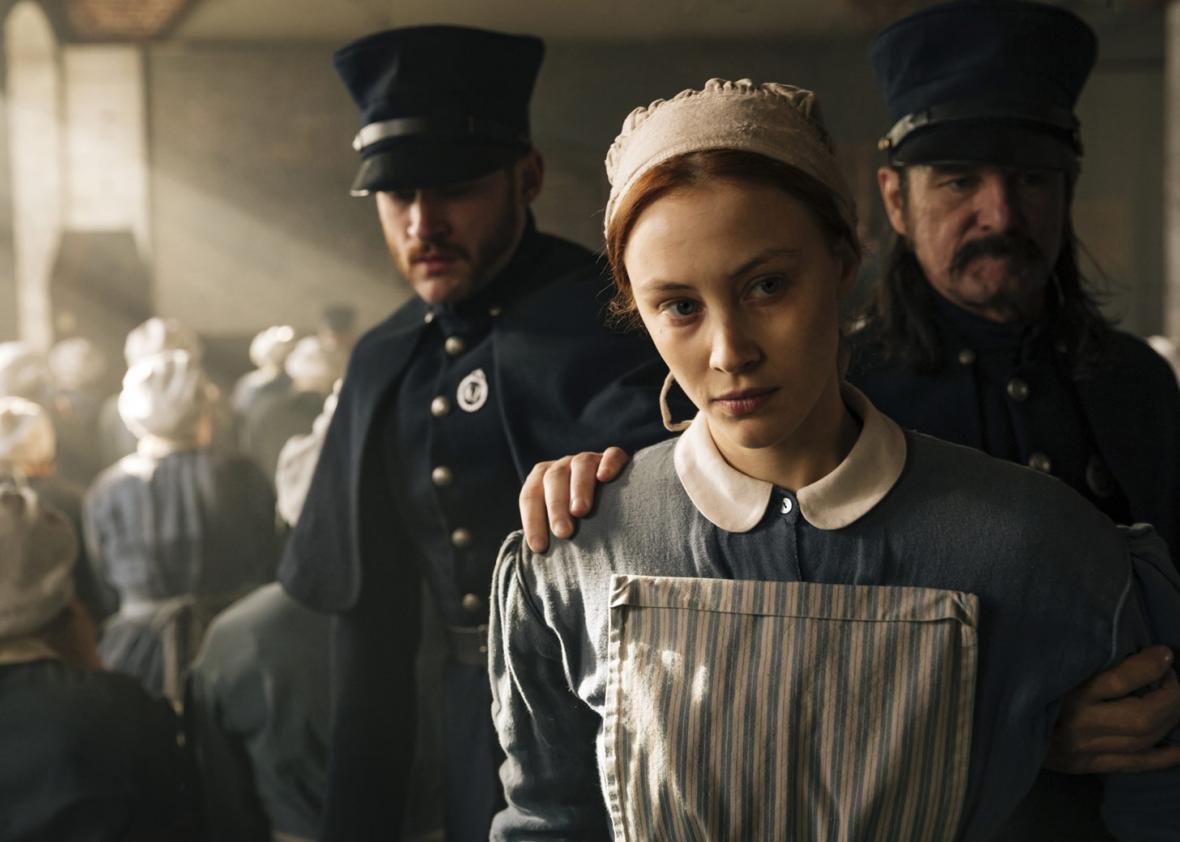Hulu’s The Handmaid’s Tale premiered in late April with sickening timing. Donald Trump’s presidency hung over Margaret Atwood’s novel, set in a dystopic, misogynist, theocratic near future, making it feel less like fiction than a terrifying prophecy. This Friday, Netflix debuts Alias Grace, another Atwood adaptation that is dreadfully apropos. The 1996 novel is historical fiction, based on an 1843 true crime, in which 16-year-old Grace Marks, an Irish immigrant to Canada, was convicted of murdering her employer, Thomas Kinnear, and his pregnant housekeeper, Nancy Montgomery. But Harvey Weinstein, our pussy-grabbing president, and their ilk loom over Alias Grace; indeed, they seem as though they could be characters in Alias Grace, where men misuse women as if it were their right.

Sarah Polley, who adapted the book for television, succinctly connected the two adaptations in a recent interview with the New York Times, saying, “The Handmaid’s Tale offers us a window into a possible future when women’s rights are eroded. Alias Grace offers a look at what it was like before women had any rights.” It doesn’t look as different from the present as we might hope.
As Alias Grace begins, the murders are 15 years in the past. Grace (Sarah Gadon) has had her sentence commuted to life in prison after a stint in an asylum. She has no recollection of the murders, though she imagines Nancy’s corpse being thrown to the ground with a staccato regularity. Grace spends her days as a servant in the nearby governor’s house, where she is showcased as an oddity while being championed by a group of upscale Canadians working to exonerate her. That group hires Dr. Simon Jordan (Edward Holcroft), an Atwood invention, a young alienist who attempts to determine Grace’s guilt using new psychological techniques. Grace and Dr. Jordan sit in the governor’s house, Grace stitching a quilt with her hands and, perhaps, a tale with her mouth.
Over the series’ six episodes, directed by Mary Harron, Grace tells Dr. Jordan her life story, or a version of it. Alias Graces uses her maybe crime as a salacious shibboleth to deliver not a whodunit, but a whydunnit, exploring the dangerous experience of being a young woman in a past that’s not quite past enough. Grace matter-of-factly presents a history full of trauma, tragedy, and abuse. Grace does not have to wear the Handmaid’s uniform, but she does wear a bonnet, its constricting forerunner, and her life is similarly endangered. Every man Grace has ever encountered—her father, her employers, her jailers, her co-workers—desires her, molests her, tries to molest her, or molests an acquaintance. A friend warns her that part of a maid’s job is avoiding the advances of gentlemen; Kinnear (Paul Gross) will later begin to eye her menacingly, when he tires of Nancy. In the asylum, she was regularly raped; in prison, she is abused by prison guards and swooned over by an increasingly besotted Dr. Jordan. Alias Grace is set 150 years ago, but you will recognize too much: the failed servant whisper network, the men who mistake manners for lust, the double standard that affords men promiscuity but women shame, the stranger who blatantly cajoles and demands an assignation, the fear of walking alone at night. Grace meets it all with furious resignation.
As Grace tells her story, she becomes increasingly slippery. The question is not simply of guilt—did she do it?—but of awareness: What does she actually know, and understand, about the events 15 years before? Gadon, as Grace, is exceptional: She provides little sleights of personality, wherein honest, well-meaning Grace suddenly drips with malice, so quickly and briefly you’re not sure it really happened. (Holcroft, as Dr. Jordan, can’t match her in subtlety; he should jump through shows and time to team up with Mindhunter’s Jonathan Groff and launch Affectless Investigators Inc.) By the time the show has worked its way to the murders, Grace herself is providing various versions of what may or may not have happened. Like Dr. Jordan, we’re not sure what to believe: Is she truthful or manipulative? Damaged or damaging, or both? Grace’s first-person narration, which hews closely to Atwood’s own language, is sometimes addressed to the doctor and sometimes to us, the audience: We’re her marks too, captivated, but with no clarity.
Whatever happened—and Alias Grace does offer a solution that you may find satisfying, depending on your feelings about Gothic plot turns run through the DSM—perhaps the darkest note in Alias Grace is the extent to which the aggressive sexism of the world has turned Grace into another vehicle of aggressive sexism. The cruelty of women toward other women is a recurring theme in Atwood’s work, not just in Alias Grace but in Cat’s Eye and The Robber Bride, and it is there in Grace’s relationship to Nancy. Whether or not she murdered her, Grace is horrified by Nancy’s relationship with Thomas Kinnear and—as Nancy comes to see Grace as a threat—is despised by her in return. The murder, of course, doesn’t matter in the end. Even without it, Alias Grace would be a tragedy: the story of two women full of hate for one another because of what men have done to them.
